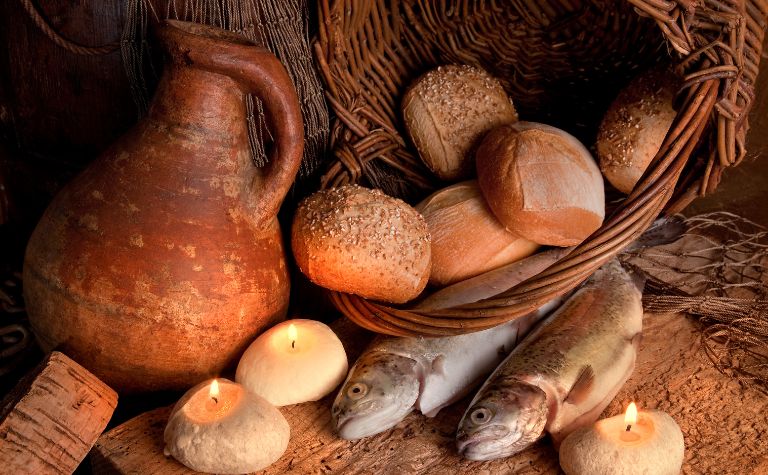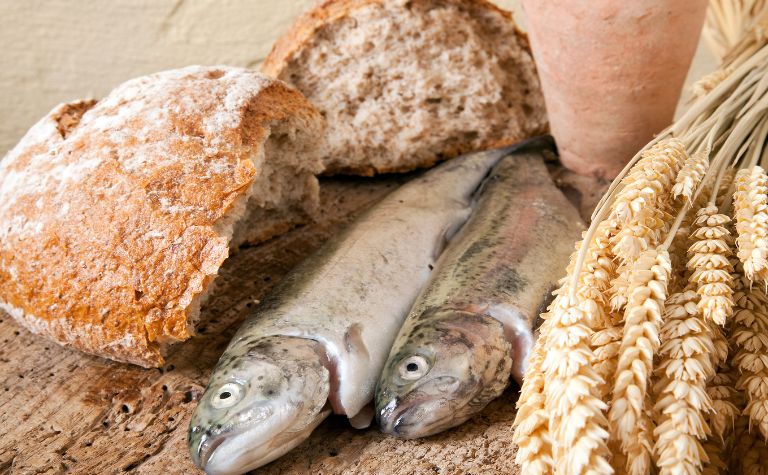Jesus performed many miracles during his public ministry. For example, he turned water into wine, healed people from physical ailments and diseases, and even rose people from the dead. Jesus also supernaturally multiplied bread and fish for people. These feedings are mentioned multiple times in the Gospels, leading Bible readers to ask how many people Jesus fed.
According to the Gospels, Jesus fed 5,000 people on one occasion and 4,000 on another. Because these stories are similar, some readers assume they are the same event but with conflicting details. Instead, the evidence is clear that while the miracles are similar, the stories differ.
What details in the stories are different? What features are similar? Do the Gospels contradict each other? Why would Matthew and Mark both include such similar stories? Keep reading to learn the answers to these questions and others, including comparison charts of the accounts.
Also, see What Is Jesus’ Favorite Color? to learn more.

Jesus Feeds 5,000 People and Then 4,000
All four Gospels mention at least one of the stories of Jesus miraculously feeding thousands of people. Mark’s Gospel provides the most detailed versions of both stories and is likely the earliest account. Mark 6:31-44 records Jesus feeding 5,000 people, and Mark 8:1-9 tells of him feeding 4,000 people.
The stories of Jesus feeding 5,000 and 4,000 have similar structures. They start with the geographical setting (6:30-34; 8:1), the crowd’s hunger (6:35-37; 8:2-4), the multiplication of bread and fish (6:38-41; 8:5-7), and the outcome (6:42-44; 8:8-10). Comparing the stories reveals similarities and differences.
| Jesus Feeds 5,000 | Jesus Feeds 4,000 |
|---|---|
| Occurs in Galilee (cf. Mk. 1:16) | Occurs in Gentile regions (cf. Mk. 7:24) |
| The disciples were hungry (Mk. 6:31) | No mention of the disciples’ hunger |
| Jesus had compassion (Mk. 6:34) | Jesus had compassion (Mk. 8:2) |
| The disciples start the conversation (Mk. 6:35) | Jesus starts the conversation (Mk. 8:3) |
| The large crowd needs food (Mk. 6:36) | The large crowd needs food (Mk. 8:1-2) |
| Jesus tells the disciples to feed them (Mk. 6:37) | No mention of explicit instruction |
| They said it would cost eight months’ pay (Mk. 6:37) | No mention of the cost |
| The disciples had five loaves and two fish (Mk. 6:38) | The disciples had seven loaves and “a few fish” (Mk. 8:5, 7) |
| Jesus Feeds 5,000 | Jesus Feeds 4,000 |
|---|---|
| The crowd sat in groups (Mk. 6:40) | The crowd sat on the ground (Mk. 8:6) |
| Jesus gave thanks (Mk. 6:41) | Jesus gave thanks (Mk. 8:6) |
| The disciples passed out the food (Mk. 6:41) | The disciples passed out the food (Mk. 8:6) |
| The crowd is satisfied (Mk. 6:42) | The crowd is satisfied (Mk. 8:8) |
| Leftovers amounted to 12 baskets (Mk. 6:43) | Leftovers amounted to 7 baskets (Mk. 8:8) |
| The number who ate was 5,000 (Mk. 6:44) | The number who ate was 4,000 (Mk. 8:9) |
| Parallels: Mark 6:31-44; Matt. 14:13-21; Luke 9:10-17; John 6:1-13 | Parallels: Mark 8:1-9; Matt. 15:32-39 |
Also, see What Son of Noah Did Jesus Come From? to learn more.

Do the Gospels Contradict Each Other?
The Gospels record that Jesus performed some miracles multiple times. For example, he healed many people of diseases and exorcised demons from several others. Some critics of the Bible allege that similar miracle stories in the Gospels are actually the same event, but the books have contradictions.
Some miracle stories have similar details
However, just because some miracle stories have similarities doesn’t mean they were the same event or that at least one of the Gospel writers recorded incorrect details. If Jesus performed certain miracles multiple times, readers should expect some details to be the same and others to be different.
For example, the Gospels record that Jesus raised more than one person from the dead. In those stories, readers should expect similarities and differences.
In the story of Jesus raising the widow’s son from the dead in Nain (Luke 7:11-17), readers observe that Luke mentions the dead body and a command from Jesus for the person to rise. Not surprisingly, similar details are found in Jesus’ resurrection of Lazarus because it’s a similar miracle (John 11:1-44).
So, do these similarities mean that these stories are the same? Did Luke or John get the details wrong, like the location where the resurrection happened or the people involved? Are the critics right?
Similarities in the stories of Jesus’ miracles mean that he performed many of them multiple times. There is no evidence to support that the Gospel writers made mistakes or were confused.
Stories of Jesus’s miraculous feedings have similarities
If Jesus multiplied bread and fish on multiple occasions, readers should expect to find similarities and differences in the stories. The similarities exist because the crowd’s need was the same, the role of the disciples was the same, and the solution to the problem was the same.
Yet the stories occur at different locations, for different crowds of people, and result in different amounts of people receiving food.
New Testament scholar Mark Strauss also notes that the Gospel writers that include both stories, Mark and Matthew, clearly believed they were different stories with similar details.
“What is clear is that the two stories differ considerably from one another, including the number of loaves, fish, people, and leftover baskets of food. Matthew and Mark both treat them as separate incidents and even have Jesus referring back to them as two independent events (Matt. 16:9-10); Mark 8:19-20).” [1]
Why would Matthew and Mark include such similar stories?
Scholars speculate why two of the Gospel writers included multiple stories of Jesus feeding thousands of people in their books. What were they trying to convey?
They may have included similar stories of miraculous feedings because the miracles occurred in different regions. One occurred in Galilee, whose rural areas were primarily Jewish, and the other happened in a Gentile region. Perhaps the Gospel’s authors wanted to show Jesus’ compassion and provision for diverse groups of people.
New Testament scholar Darrell Bock suggests that including similar stories reflects that people have multiple opportunities to respond to Jesus. Even though he kept giving people reasons to put their faith in him, they continually rejected him.
“The continuation of these kinds of actions in the face of ongoing opposition indicates that Jesus’s ministry proceeds to offer blessing and opportunity to respond. The continued rejection of him in light of the repetition reveals how deep the hardness of heart was in refusing to embrace the stream of work that Jesus provided.” [2]
Also, see What Day Did Jesus Rise from the Dead? to learn more.

Do Jesus’ Feedings Have An Old Testament Basis?
Some scholars believe Jesus’ miraculous feedings recall God’s provision of manna for the Israelites during the wilderness wanderings (Exod. 16; Num. 11).
Another story from the Old Testament that Jesus’ multiplication of food alludes to is when Elijah used 20 loaves to feed a few hundred people (2 Kings 4:42-44), compared to Jesus, who used fewer loaves to feed several thousand on multiple occasions.
Also, see Why Did Jesus Come to Earth? to learn more.
References:
[1] Mark by Mark Strauss. ZECNT. p. 272.
[2] Jesus According to Scripture by Darrell Bock. p. 312.
Related Questions
A lot of people know that Jesus of Nazareth lived a long time ago. They may even know that he was a Jewish man born at the time of the Roman Empire. Yet, they are unclear about exactly when he was on...
One of the most fascinating scenes in the Gospel of John is when religious leaders bring a woman to Jesus who was guilty of adultery. The punishment for adultery according to the Law of Moses was...
